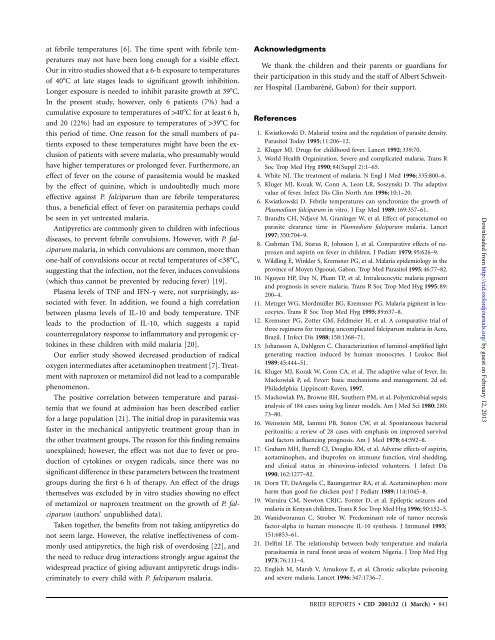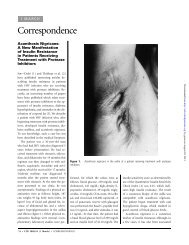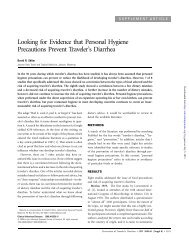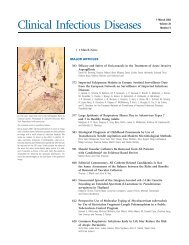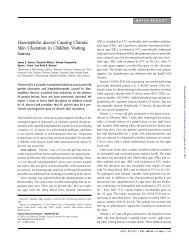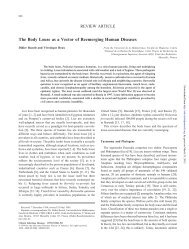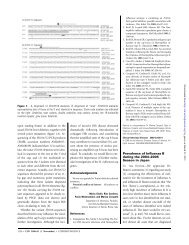Effect of Antipyretic Drugs in Children with Malaria - Clinical ...
Effect of Antipyretic Drugs in Children with Malaria - Clinical ...
Effect of Antipyretic Drugs in Children with Malaria - Clinical ...
Create successful ePaper yourself
Turn your PDF publications into a flip-book with our unique Google optimized e-Paper software.
at febrile temperatures [6]. The time spent <strong>with</strong> febrile temperatures<br />
may not have been long enough for a visible effect.<br />
Our <strong>in</strong> vitro studies showed that a 6-h exposure to temperatures<br />
<strong>of</strong> 40�C at late stages leads to significant growth <strong>in</strong>hibition.<br />
Longer exposure is needed to <strong>in</strong>hibit parasite growth at 39�C.<br />
In the present study, however, only 6 patients (7%) had a<br />
cumulative exposure to temperatures <strong>of</strong> 140�C for at least 6 h,<br />
and 20 (22%) had an exposure to temperatures <strong>of</strong> 139�C for<br />
this period <strong>of</strong> time. One reason for the small numbers <strong>of</strong> patients<br />
exposed to these temperatures might have been the exclusion<br />
<strong>of</strong> patients <strong>with</strong> severe malaria, who presumably would<br />
have higher temperatures or prolonged fever. Furthermore, an<br />
effect <strong>of</strong> fever on the course <strong>of</strong> parasitemia would be masked<br />
by the effect <strong>of</strong> qu<strong>in</strong><strong>in</strong>e, which is undoubtedly much more<br />
effective aga<strong>in</strong>st P. falciparum than are febrile temperatures;<br />
thus, a beneficial effect <strong>of</strong> fever on parasitemia perhaps could<br />
be seen <strong>in</strong> yet untreated malaria.<br />
<strong>Antipyretic</strong>s are commonly given to children <strong>with</strong> <strong>in</strong>fectious<br />
diseases, to prevent febrile convulsions. However, <strong>with</strong> P. falciparum<br />
malaria, <strong>in</strong> which convulsions are common, more than<br />
one-half <strong>of</strong> convulsions occur at rectal temperatures <strong>of</strong> !38�C,<br />
suggest<strong>in</strong>g that the <strong>in</strong>fection, not the fever, <strong>in</strong>duces convulsions<br />
(which thus cannot be prevented by reduc<strong>in</strong>g fever) [19].<br />
Plasma levels <strong>of</strong> TNF and IFN-g were, not surpris<strong>in</strong>gly, associated<br />
<strong>with</strong> fever. In addition, we found a high correlation<br />
between plasma levels <strong>of</strong> IL-10 and body temperature. TNF<br />
leads to the production <strong>of</strong> IL-10, which suggests a rapid<br />
counterregulatory response to <strong>in</strong>flammatory and pyrogenic cytok<strong>in</strong>es<br />
<strong>in</strong> these children <strong>with</strong> mild malaria [20].<br />
Our earlier study showed decreased production <strong>of</strong> radical<br />
oxygen <strong>in</strong>termediates after acetam<strong>in</strong>ophen treatment [7]. Treatment<br />
<strong>with</strong> naproxen or metamizol did not lead to a comparable<br />
phenomenon.<br />
The positive correlation between temperature and parasitemia<br />
that we found at admission has been described earlier<br />
for a large population [21]. The <strong>in</strong>itial drop <strong>in</strong> parasitemia was<br />
faster <strong>in</strong> the mechanical antipyretic treatment group than <strong>in</strong><br />
the other treatment groups. The reason for this f<strong>in</strong>d<strong>in</strong>g rema<strong>in</strong>s<br />
unexpla<strong>in</strong>ed; however, the effect was not due to fever or production<br />
<strong>of</strong> cytok<strong>in</strong>es or oxygen radicals, s<strong>in</strong>ce there was no<br />
significant difference <strong>in</strong> these parameters between the treatment<br />
groups dur<strong>in</strong>g the first 6 h <strong>of</strong> therapy. An effect <strong>of</strong> the drugs<br />
themselves was excluded by <strong>in</strong> vitro studies show<strong>in</strong>g no effect<br />
<strong>of</strong> metamizol or naproxen treatment on the growth <strong>of</strong> P. falciparum<br />
(authors’ unpublished data).<br />
Taken together, the benefits from not tak<strong>in</strong>g antipyretics do<br />
not seem large. However, the relative <strong>in</strong>effectiveness <strong>of</strong> commonly<br />
used antipyretics, the high risk <strong>of</strong> overdos<strong>in</strong>g [22], and<br />
the need to reduce drug <strong>in</strong>teractions strongly argue aga<strong>in</strong>st the<br />
widespread practice <strong>of</strong> giv<strong>in</strong>g adjuvant antipyretic drugs <strong>in</strong>discrim<strong>in</strong>ately<br />
to every child <strong>with</strong> P. falciparum malaria.<br />
Acknowledgments<br />
We thank the children and their parents or guardians for<br />
their participation <strong>in</strong> this study and the staff <strong>of</strong> Albert Schweitzer<br />
Hospital (Lambaréné, Gabon) for their support.<br />
References<br />
1. Kwiatkowski D. <strong>Malaria</strong>l tox<strong>in</strong>s and the regulation <strong>of</strong> parasite density.<br />
Parasitol Today 1995; 11:206–12.<br />
2. Kluger MJ. <strong>Drugs</strong> for childhood fever. Lancet 1992; 339:70.<br />
3. World Health Organization. Severe and complicated malaria. Trans R<br />
Soc Trop Med Hyg 1990; 84(Suppl 2):1–65.<br />
4. White NJ. The treatment <strong>of</strong> malaria. N Engl J Med 1996; 335:800–6.<br />
5. Kluger MJ, Kozak W, Conn A, Leon LR, Soszynski D. The adaptive<br />
value <strong>of</strong> fever. Infect Dis Cl<strong>in</strong> North Am 1996; 10:1–20.<br />
6. Kwiatkowski D. Febrile temperatures can synchronize the growth <strong>of</strong><br />
Plasmodium falciparum <strong>in</strong> vitro. J Exp Med 1989; 169:357–61.<br />
7. Brandts CH, Ndjavé M, Gran<strong>in</strong>ger W, et al. <strong>Effect</strong> <strong>of</strong> paracetamol on<br />
parasite clearance time <strong>in</strong> Plasmodium falciparum malaria. Lancet<br />
1997; 350:704–9.<br />
8. Cashman TM, Starus R, Johnson J, et al. Comparative effects <strong>of</strong> naproxen<br />
and aspir<strong>in</strong> on fever <strong>in</strong> children. J Pediatr 1979; 95:626–9.<br />
9. Wildl<strong>in</strong>g E, W<strong>in</strong>kler S, Kremsner PG, et al. <strong>Malaria</strong> epidemiology <strong>in</strong> the<br />
prov<strong>in</strong>ce <strong>of</strong> Moyen Ogooué, Gabon. Trop Med Parasitol 1995; 46:77–82.<br />
10. Nguyen HP, Day N, Pham TP, et al. Intraleucocytic malaria pigment<br />
and prognosis <strong>in</strong> severe malaria. Trans R Soc Trop Med Hyg 1995; 89:<br />
200–4.<br />
11. Metzger WG, Mordmüller BG, Kremsner PG. <strong>Malaria</strong> pigment <strong>in</strong> leucocytes.<br />
Trans R Soc Trop Med Hyg 1995; 89:637–8.<br />
12. Kremsner PG, Zotter GM, Feldmeier H, et al. A comparative trial <strong>of</strong><br />
three regimens for treat<strong>in</strong>g uncomplicated falciparum malaria <strong>in</strong> Acre,<br />
Brazil. J Infect Dis 1988; 158:1368–71.<br />
13. Johansson A, Dahlgren C. Characterization <strong>of</strong> lum<strong>in</strong>ol-amplified light<br />
generat<strong>in</strong>g reaction <strong>in</strong>duced by human monocytes. J Leukoc Biol<br />
1989; 45:444–51.<br />
14. Kluger MJ, Kozak W, Conn CA, et al. The adaptive value <strong>of</strong> fever. In:<br />
Mackowiak P, ed. Fever: basic mechanisms and management. 2d ed.<br />
Philadelphia: Lipp<strong>in</strong>cott-Raven, 1997.<br />
15. Mackowiak PA, Browne RH, Southern PM, et al. Polymicrobial sepsis;<br />
analysis <strong>of</strong> 184 cases us<strong>in</strong>g log l<strong>in</strong>ear models. Am J Med Sci 1980; 280:<br />
73–80.<br />
16. We<strong>in</strong>ste<strong>in</strong> MR, Iann<strong>in</strong>i PB, Staton CW, et al. Spontaneous bacterial<br />
peritonitis: a review <strong>of</strong> 28 cases <strong>with</strong> emphasis on improved survival<br />
and factors <strong>in</strong>fluenc<strong>in</strong>g prognosis. Am J Med 1978; 64:592–8.<br />
17. Graham MH, Burrell CJ, Douglas RM, et al. Adverse effects <strong>of</strong> aspir<strong>in</strong>,<br />
acetam<strong>in</strong>ophen, and ibupr<strong>of</strong>en on immune function, viral shedd<strong>in</strong>g,<br />
and cl<strong>in</strong>ical status <strong>in</strong> rh<strong>in</strong>ovirus-<strong>in</strong>fected volunteers. J Infect Dis<br />
1990; 162:1277–82.<br />
18. Dorn TF, DeAngelis C, Baumgartner RA, et al. Acetam<strong>in</strong>ophen: more<br />
harm than good for chicken pox? J Pediatr 1989; 114:1045–8.<br />
19. Waruiru CM, Newton CRJC, Forster D, et al. Epileptic seizures and<br />
malaria <strong>in</strong> Kenyan children. Trans R Soc Trop Med Hyg 1996; 90:152–5.<br />
20. Wanidworanun C, Strober W. Predom<strong>in</strong>ant role <strong>of</strong> tumor necrosis<br />
factor-alpha <strong>in</strong> human monocyte IL-10 synthesis. J Immunol 1993;<br />
151:6853–61.<br />
21. Delf<strong>in</strong>i LF. The relationship between body temperature and malaria<br />
parasitaemia <strong>in</strong> rural forest areas <strong>of</strong> western Nigeria. J Trop Med Hyg<br />
1973; 76:111–4.<br />
22. English M, Marsh V, Amukoye E, et al. Chronic salicylate poison<strong>in</strong>g<br />
and severe malaria. Lancet 1996; 347:1736–7.<br />
BRIEF REPORTS • CID 2001:32 (1 March) • 841<br />
Downloaded from<br />
http://cid.oxfordjournals.org/ by guest on February 12, 2013


